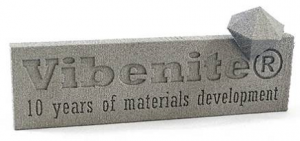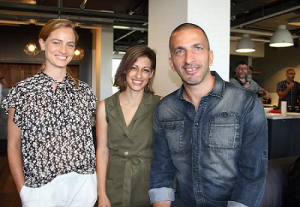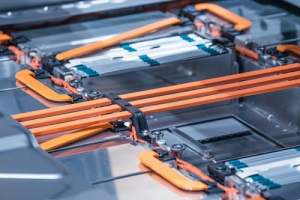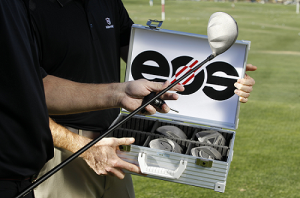We’re starting with some business news in today’s 3D Printing News Briefs, including stories about a new 3D printer, an anniversary, and a 3D printing investment. Cincinnati Incorporated has launched a new high temperature version of its SAAM 3D printer, and EOS will supply Visser Precision with five new metal 3D printers, including its M 400-4. VBN Components celebrates its tenth anniversary, and an Israeli 3D printing startup has received about $400,000 in funding. Researchers in Iran have successfully 3D printed flexible electronic circuits, and 3D printing was used to replicate a Chinese grotto. Finally, the Golf Channel will be featuring 3D printed golf clubs tonight.
New High Temperature Version of SAAM 3D Printer
 Last week at FABTECH 2018 in Georgia, build-to-order machine tool manufacturer Cincinnati Incorporated (CI) launched a brand new high temperature version of its SAAM (Small Area Additive Manufacturing) 3D printer series. The SAAM HT 3D printer has a nozzle that can sustain temperatures up to 450°C and a bed temperature up to 260°C, which makes it possible to process materials like polycarbonate, PEEK, and ULTEM. Courtesy of its continuous patented automatic-ejection mechanism, the SAAM HT can be used for small batch production, and is a good choice for manufacturing tooling involved in high temperature operations.
Last week at FABTECH 2018 in Georgia, build-to-order machine tool manufacturer Cincinnati Incorporated (CI) launched a brand new high temperature version of its SAAM (Small Area Additive Manufacturing) 3D printer series. The SAAM HT 3D printer has a nozzle that can sustain temperatures up to 450°C and a bed temperature up to 260°C, which makes it possible to process materials like polycarbonate, PEEK, and ULTEM. Courtesy of its continuous patented automatic-ejection mechanism, the SAAM HT can be used for small batch production, and is a good choice for manufacturing tooling involved in high temperature operations.
“All materials compatible with SAAM can be used on the HT version. This level of versatility makes it a valuable asset in any manufacturing setting. We are enabling manufacturers and engineers to create the custom parts they need for their most demanding applications,” said Chris Haid, the General Manager of the NVBOTS Business Unit at CI.
EOS Supplying Visser Precision with New Metal 3D Printers
Denver-based Visser Precision, which provides advanced metals manufacturing solutions, has doubled its metal 3D printing capacity, thanks to the terms of an agreement reached with EOS at the recent IMTS trade fair. Visser has purchased three EOS M 400-4 3D printers, and two of the recently introduced EOS M 300-4 systems, making it the first organization to acquire the new platform. Market demands for DMLS-quality metal components in industries like aerospace and defense led Visser to grow its metal 3D printer capacity, and the new EOS systems will be delivered in a few months.
Ryan Coniam, the President of Visser Precision, said, “Our customers require the highest-performance, highest quality components and we feel partnering with EOS – the metal AM industry pioneers and leaders in DMLS – provides us with the capabilities we need to meet market demands now and in the next few years. Nearly anyone nowadays can 3D print something in metal, the trick is repeatability while meeting and maintaining quality and our investments with EOS mean we can deliver that to our customers.”
VBN Components Celebrating 10 Years in Business
 Swedish materials development company VBN Components AB was founded in the midst of the 2008 financial crisis, and has come a long way since then. The award-winning company works to continuously develop new and better materials, including its corrosion and wear resistant Vibenite 350 for the plastics industry and Vibenite 290, the “World’s Hardest Steel.”
Swedish materials development company VBN Components AB was founded in the midst of the 2008 financial crisis, and has come a long way since then. The award-winning company works to continuously develop new and better materials, including its corrosion and wear resistant Vibenite 350 for the plastics industry and Vibenite 290, the “World’s Hardest Steel.”
Martin Nilsson, CEO and one of the founders of VBN Components, said, “After our first patent, describing the process of making extremely clean and low-oxygen-rate materials, we realised that we were on to something big.”
This year, VBN Components is celebrating 10 years in business, with several patents and new, hard materials under its belt. But stay tuned – the company will soon unveil the greatest news in its history, which has been described as “a revolution in material development.”
Israeli 3D Printing Startup Receives Funding

TAU Ventures team, R-L: Nimrod Cohen, Managing Partner at TAU Ventures; Shira Gal, Director of Incubator Programs; Yaara Benbenishty, Director of Marketing and Operations [Image: Eylon Yehiel]
The startup will be receiving about $400,000 in combined funding from Stanley Black & Decker, the Techstars Accelerator, British businessman Jeremy Coller, and TAU Ventures, which is the first and only academic-based venture capital fund in Israel.
3D Printing Flexible Electronic Circuits
 Researchers from a knowledge-based company in Iran have recently developed 3D printers that can fabricate flexible electronic circuits, which could be used in the future as wearables for clothing, pressure sensors, or industrial talc for cars.
Researchers from a knowledge-based company in Iran have recently developed 3D printers that can fabricate flexible electronic circuits, which could be used in the future as wearables for clothing, pressure sensors, or industrial talc for cars.
The unnamed company’s project manager, Ali Gharekhani, told Mehr News that these 3D printers only take a few seconds to 3D print the flexible electronic circuits, and that foreign versions of this system are “very expensive.” Gharekhani also said that in light of this new development, his company has already received some proposals for Turkey, and “intends to reach an agreement with the Turkish side on production of clothes by 3D printers” before its rivals in Germany, Canada, and Korea.
3D Printed Replica of Chinese Grotto

Yungang Grottoes are a cradle of Buddhist art, playing host to more than 51,000 sculptures. [Image: Zhang Xingjian, China Daily]
“We plan to color it with mineral pigments before the end of this year,” said Zhang Zhuo, head of the institute. “In this way, the replica will maintain its original size, texture and color.”
In the future, the 3D printed grotto replica will be added to exhibition tours with the institute’s other cultural relics.
3D Printed Golf Clubs on the Golf Channel
 Tonight, at 9 pm EDT, EOS will be featured, together with Wilson Golf, on the NBC Golf Channel show Driver Vs. Driver. The seven-episode series follows aspiring designers of golf equipment as they compete against each other for the chance to win $500,000. In addition to the money, the winner will also have the opportunity to have their driver design sold, under the Wilson Staff name, at retail stores.
Tonight, at 9 pm EDT, EOS will be featured, together with Wilson Golf, on the NBC Golf Channel show Driver Vs. Driver. The seven-episode series follows aspiring designers of golf equipment as they compete against each other for the chance to win $500,000. In addition to the money, the winner will also have the opportunity to have their driver design sold, under the Wilson Staff name, at retail stores.
The show gives viewers a behind the scenes look as advancing teams work with engineers at the company’s innovation hub, Wilson LABS, to evaluate, refine, and test out their concepts. Tonight is the third episode, and showcases several designers’ use of 3D printing to make the best golf driver club. Wilson is among a few other companies, including Krone Golf, Ping, Callaway Golf Company, and Cobra Puma Golf, that is using 3D printing to produce golf clubs and other equipment.
Discuss these stories and other 3D printing topics at 3DPrintBoard.com or share your thoughts below.
Subscribe to Our Email Newsletter
Stay up-to-date on all the latest news from the 3D printing industry and receive information and offers from third party vendors.
You May Also Like
3D Printing Unpeeled: New Arkema Material for HP, Saddle and Macro MEMS
A new Arkema material for MJF is said to reduce costs per part by up to 25% and have an 85% reusability ratio. HP 3D HR PA 12 S has been...
3D Printing News Briefs, January 20, 2024: FDM, LPBF, Underwater 3D Printer, Racing, & More
We’re starting off with a process certification in today’s 3D Printing News Briefs, and then moving on to research about solute trapping, laser powder bed fusion, and then moving on...
3D Printing Webinar and Event Roundup: December 3, 2023
We’ve got plenty of events and webinars coming up for you this week! Quickparts is having a Manufacturing Roadshow, America Makes is holding a Member Town Hall, Stratafest makes two...
Formnext 2023 Day Three: Slam Dunk
I’m high—high on trade show. I’ve met numerous new faces and reconnected with old friends, creating an absolutely wonderful atmosphere. The excitement is palpable over several emerging developments. The high...
































